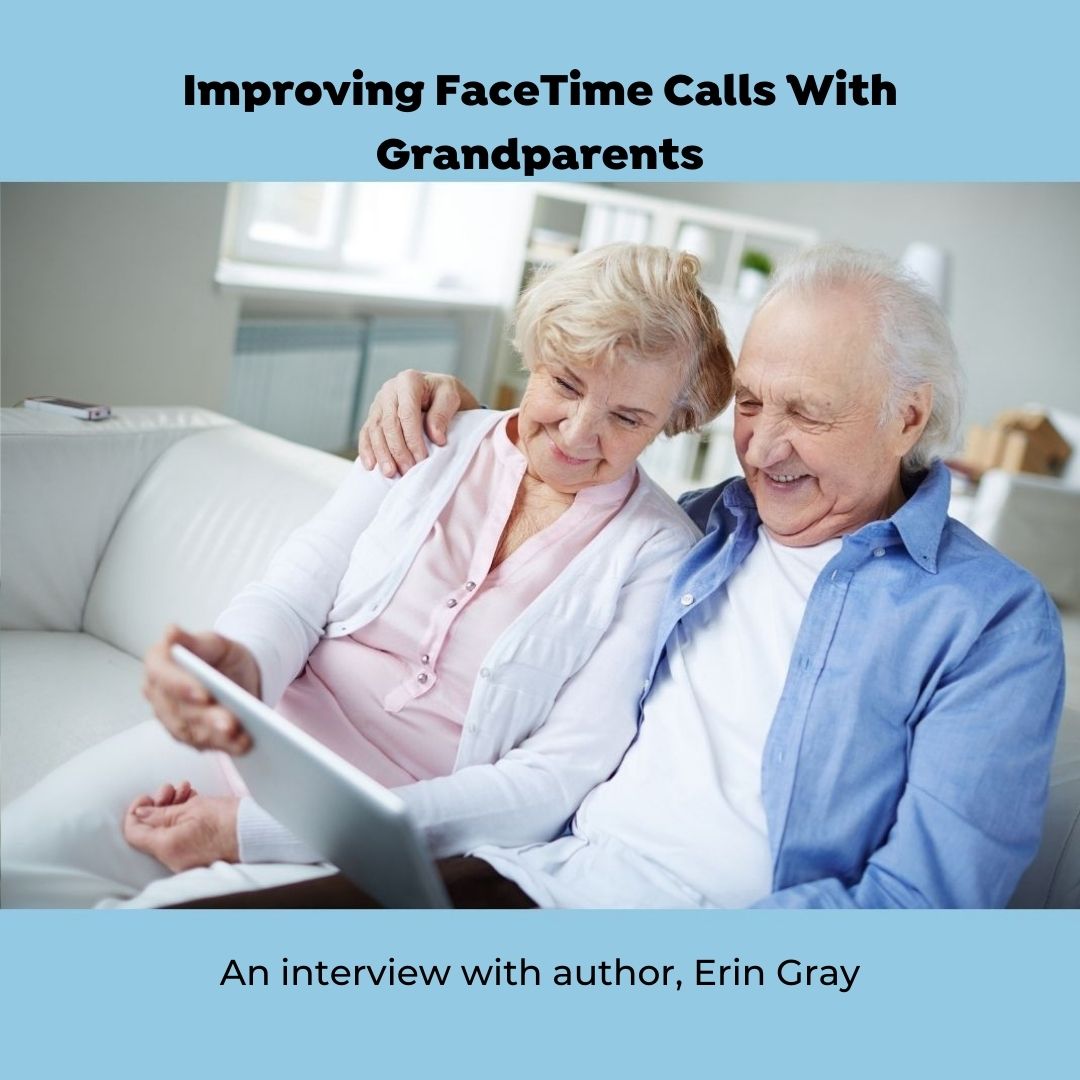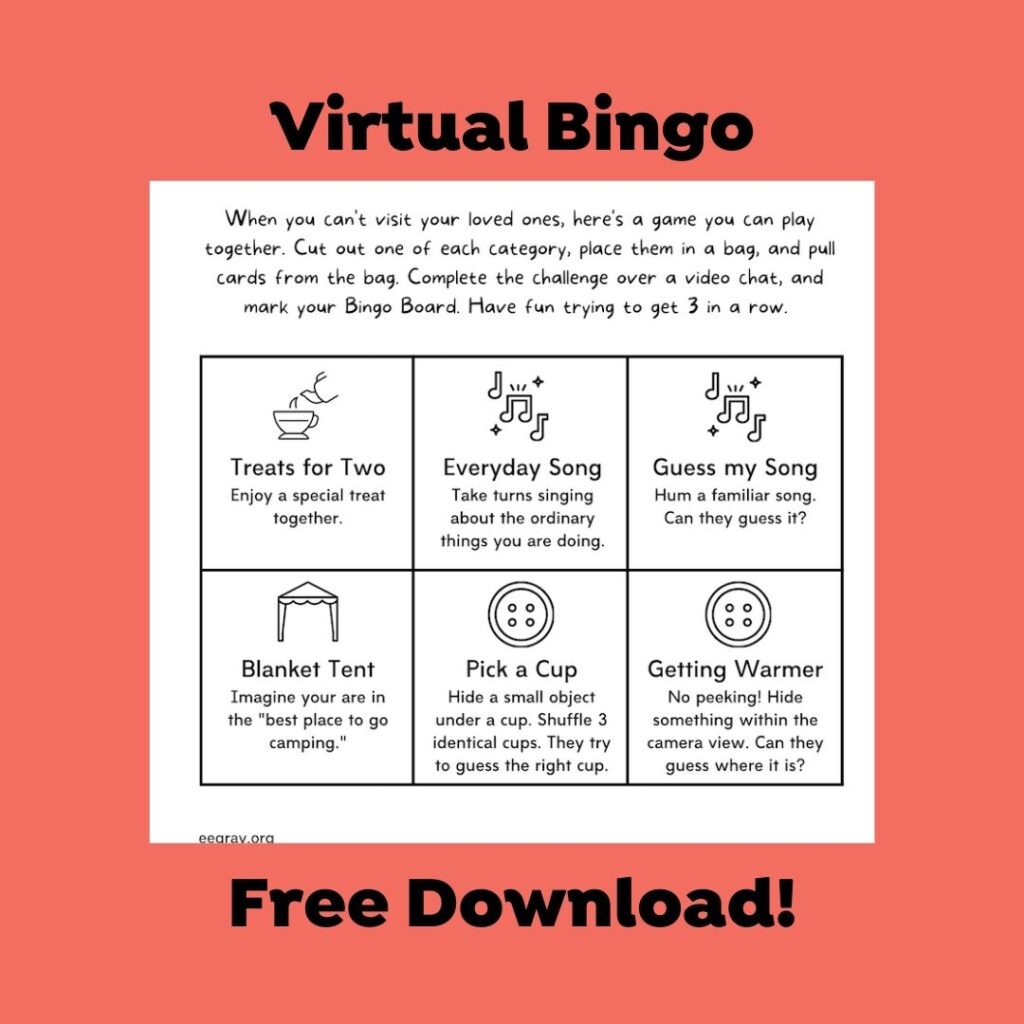Improving FaceTime calls with Grandchildren is high on our priority list, so we sat down with author Erin Gray who has recently written a children’s book on the topic. These concepts aren’t limited to FaceTime, of course. Google Duo, Zoom, Microsoft Teams, and a host of other video platforms will help you improve the quality of your FaceTime calls with grandchildren.
Improving FaceTime Calls with Grandchildren: An Interview With Erin Gray
Lynnae Allred: Welcome Erin, and tell us just a little bit about the inspiration for this really sweet book, a little bit about the book itself, and maybe something about you and how you came to publish it
The Idea to Write a Children’s Book About Better Video Calls:
Erin Gray: Yes, I’m a mom of an almost 3-year-old, and this past year, we had read the book, Bedtime for Frances. He had read the whole part about the piggyback ride and he came up with the idea of giving his grandparents—Grammy and Pop—a piggyback ride as he went up the stairs to bed. I just thought, “Wow! This is so much fun. I hope everybody else is having this much fun with their FaceTime calls. So that’s what inspired me to write the book, I Can’t, But I Can.”
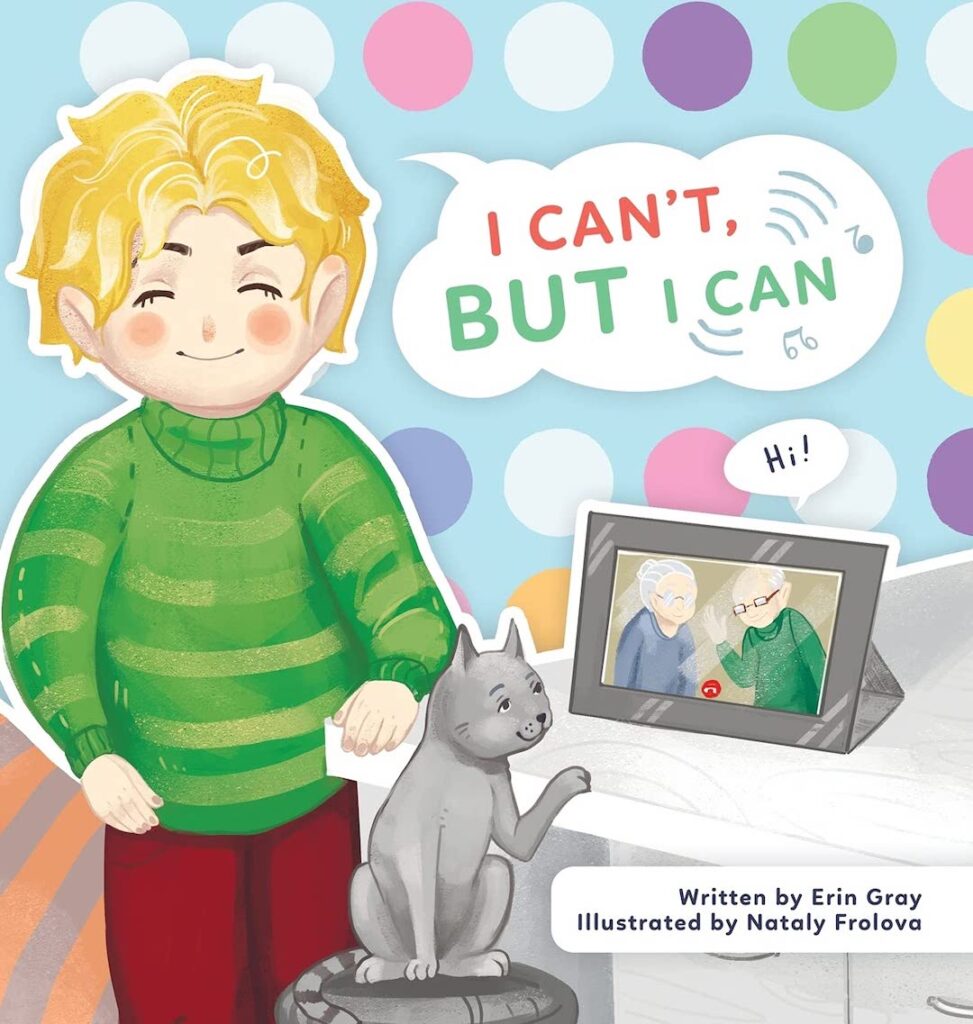
Erin’s book: I Can’t But I Can. This fun picture book is all about the ways a child can connect virtually. FaceTime calls with Grandchildren can be a lot of fun!
About Erin Gray:
A little bit about me: I am a teacher. I’ve been an administrator, a curriculum writer and instructional coach, and mentor. Currently, I am spending the majority of my day as a stay-at-home Mom, and so I get to enjoy these moments with my little one and so I decided to jump into writing for children because children’s literature is so much fun. And I’m hoping other people are enjoying FaceTime as much as we are.
Lynnae: When you had this first “aha moment” and this piggyback ride was happening going up the stairs, was it at that moment that you went, “Wait a second. What are some of the other ways that I can really implement this connection with grandparents and a grandchild even though they are hundreds of miles apart?” Maybe talk for a little bit about your mother or your father—the grandparents of this little boy—and how he started to help you generate ideas of ways that he wanted to connect that were fun for him.
Making Connections: Improving FaceTime Calls With Grandchildren is Easy and Fun
Erin: Yeah, absolutely. So it’s a little scary to hand your phone to your toddler, but it’s amazing to see what they do when they’re given that freedom to actually play with their grandparents live, online.
 The first key for improving your FaceTime calls with Grandchildren is to create consistency and frequency.
The first key for improving your FaceTime calls with Grandchildren is to create consistency and frequency.
So that was really the inspiration for me. My mom is the kind of grandma that the miles won’t stop her. She’s like the UBER Grandma. She’s amazing. And she’s always looking for ways to reach out and connect. It doesn’t matter if it’s FaceTime. I think we got two postcards in the mail today. So she’s just always thinking of things and sending things. So this was just one avenue that they have used to engage with their grandson even though we are separated. We’re a six-hour drive away so even without the pandemic, It’s not possible for us to spend as much time together as we would like to spend.
Lynnae: And I think that’s true for a lot of us grandparents. It’s kind of a different generation. I guess, historically, children and grandparents were reasonably close to each other, but that’s just not the case very often anymore. Yet, there’s that real inner drive. I don’t have the words to describe what I feel about it, but a real living breathing desire that I have to be able to connect with my grandchildren. To have a relationship with them. To know who they are, to know what’s going on in their lives, and to have them trust and love me, even though they are a long way away. We have these amazing technologies that allow us to do that now. The tricky part is how to get beyond the same-old, same-old FaceTime call and do something a little bit different—which is what your book focuses on.
What’s Inside of the Book?
Do you want to talk about the book for a moment?
Erin: Yes. Let’s take a peek at a few of the pages here. So some of the different things that I tried to show throughout the book were ways that you can go beyond just talking. How can you actually bring your grandparents into the action, into the life of the child so that they really feel like they’re together. Whether it’s sharing a story together, maybe it is actually pretending to have a tea party or a snack together. Those are ways that they can interact that takes Grammy and Pop from being the spectator to actually being a firsthand participant in the child’s life. Which is really what I think you were saying is the main desire of a grandmother—to be involved, and not just seeing video clips from the highlights reel, but to actually be part of the action.
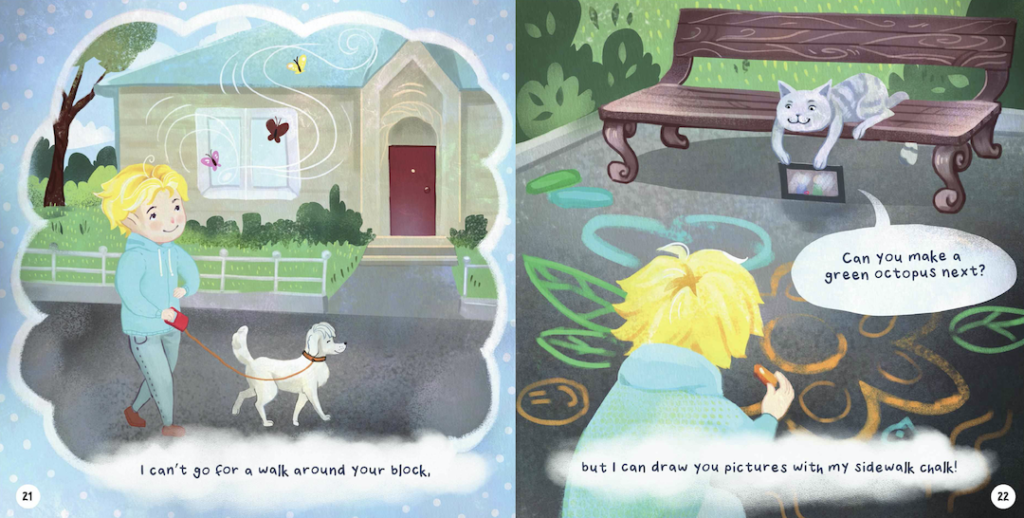
The premise of this picture book is to show all of the creative, fun ways grandkids and grandparents can connect online using FaceTime or another video call option.
Lynnae: Exactly, and so as you can see from these really sweet little illustrations, there’s kind of an “I Can’t, But I Can” back and forth going on here in this book. All the things that this little boy can’t do because he can’t be in person with his grandparents: “I can’t have a taste of your yummy beef stew. But I can play hide and seek with you.” And so if you look close there, you’ll see the iPad, down in the bottom under the pillows, and grandma and grandpa telling him, “Oh, you’re getting warmer…”
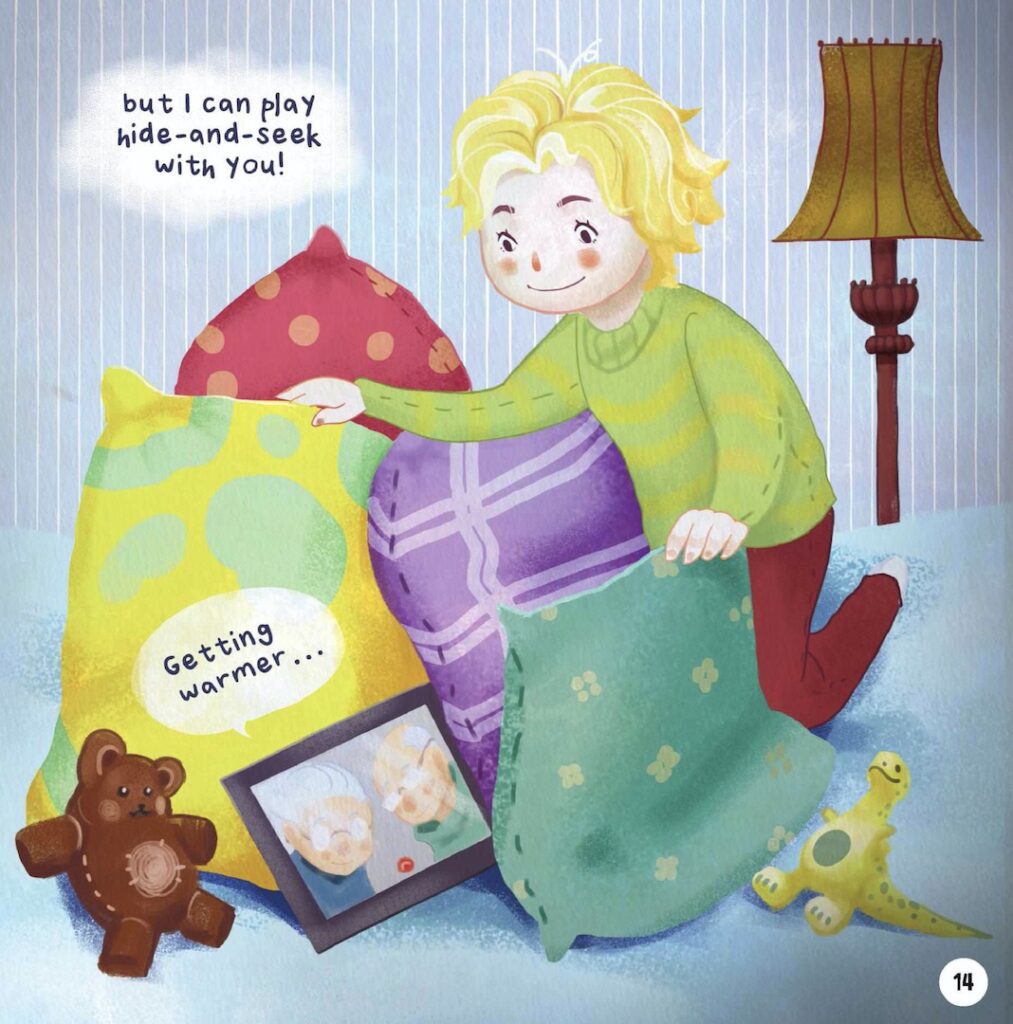 Erin’s book shows that improving a FaceTime call with grandchildren simply requires a little flexibility, a little creativity, and letting the child lead.
Erin’s book shows that improving a FaceTime call with grandchildren simply requires a little flexibility, a little creativity, and letting the child lead.
Lynnae: Do you actually do these kinds of things? Does your son actually do this sort of thing with his grandparents?
Erin: Yes we do! They’ve been hidden in the box. They’ve been stuck in a [toy] semi-trailer—all kinds of toys they’ve been tucked into [meaning, the phone has been tucked inside of a truck]. I didn’t show this in the book, but there’s lots of rides down the slide together. We definitely share snacks together. Lunchtime is a favorite. I don’t know, you’re sitting around the lunch table together and it’s kind of a good time to think about, “Hey, let’s make a call.”
So there has been many a snack shared through the phone as best we can.
Lynnae: I think that was my first “aha” moment when I was playing virtually with one of my grandchildren over Zoom and he asked me for chocolate chips. Because when he comes to visit, he always goes to the pantry with Grandpa and gets a handful of chocolate chips. And so that screen just immediately melted away and I realized, “I am in the room with him. How can I now take advantage of this joyful connection that I have with him?
Hint #1: Phone Placement During FaceTime Calls
You mentioned the placement of the phone. Talk to me just a little bit about how you’ve trained your child to help grandma and grandpa be able to see what’s going on in his world.

It takes a little bit of practice for a child to hold the phone on their end so that grandparents can see them well.
Erin: Yes. That’s not an easy thing, actually. As I said, he’s almost three, so sometimes, I do have to help him with that and help him think about it. Like right now, I have my phone on a stand. So sometimes using that, I actually clip it to the table. So I set the placement so that they can see and we both can get in the view, and we share lunch together. That helps so the phone isn’t flopping everywhere. Sometimes I even just try and remind him when we are playing in the room, “Where can you put the phone so they can actually see you on the slide sliding towards them?”
They’re better able to be a cheerleader and a coach and encourage him when they can actually see the room and not be staring at the ceiling, or as I said, stuck in a toy or in a truck. They really don’t know what’s going on at that point. It definitely helps them feel more a part of what’s happening if you’re paying attention to the phone placement, and just even help re-position it as much as possible.
Hint #2: Allow the Parent to be the Facilitator of Grandparent/Grandchild FaceTime Call
Lynnae: What do you feel is the most critical component of making these connections happen? You’ve got a grandparent who may or may not be a little bit technologically challenged. You’ve got a child, who, if we’re looking at a preschooler or a very young child, may not have the ability to pick up the phone and dial Grandma’s number. What is your role in this connection experience?
Erin: Yeah, a lot of what I see is I’m a bit of a facilitator. I facilitate the fact that we make a point to make the call. I have to set up a time or think about when we’re going to do this. One thing that helps me, because you could have good intentions about making those calls and making this time, but I try to think about some things that trigger—make it almost a routine.

Like I said, lunch is a good time that we’re sitting there together. Sometimes we have things to talk about, sometimes we don’t. But that’s an easy time to pull out the phone and jump into your conversation. Lunchtime is a good automatic, “Let’s make a call right now.” Maybe I’m making dinner and I really want to put him on a call and have him busy for a few minutes so I can concentrate on what I’m doing. So those things kind of help. And then just sort of listening in. Watching what he’s doing, listening to what they’re saying. If they want to see something or they can’t see something, trying to move the phone so they can better interact and know what’s going on. All of that can kind of help facilitate the conversation.
Playing Virtually Works Across Generations
Lynnae: What are some of the most memorable experiences that you have had virtually that kind of broke the boundaries of a simple conversation over the phone?
Erin: One really neat conversation that I had with my son’s great-grandmother. It’s just a lot of fun watching a grandparent or a great-grandparent see what’s going on and actually be able to influence the play that’s happening. He was rolling a train on the track first and she said, “What would happen if you rolled the ball on the track?”
And he said, “Oh, let me try that!” And so just to have that conversational back-and-forth, to me is very special. I feel like that’s not just a one-way conversation, but they’re actually interacting and engaging with one another. That’s always very memorable to me when those types of moments happen.
Creating Shared Experiences
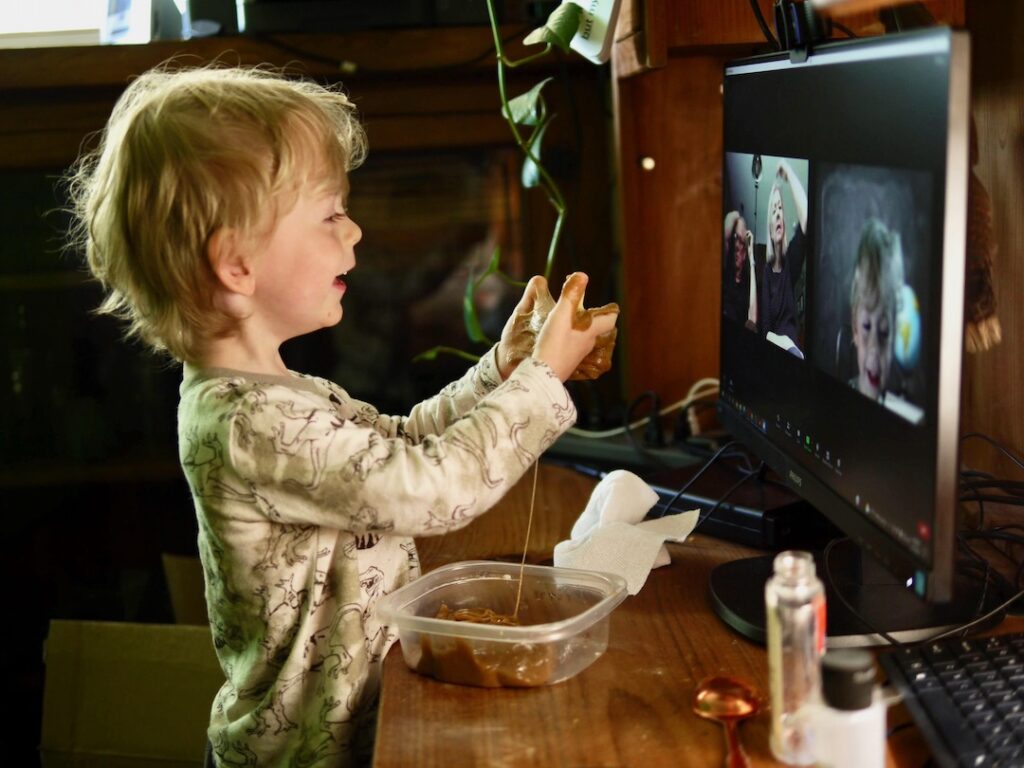 Playing with sand slime from the Seashell Playdatebox as Grandparents play along
Playing with sand slime from the Seashell Playdatebox as Grandparents play along
Lynnae: I think that’s been our goal as we’ve created these Playdateboxes. That’s exactly what we’re up to, is trying to put enough tools into a container for somebody that they can open it up and here are six playdates that I can pull out, and most of them are things that we can do virtually. They’re not super intuitive to think about. For example, playing with slime. If Grandma’s making slime in her kitchen in Nebraska and somebody else is making slime in their kitchen in Colorado, and we’re still doing it together—there are some logistics that go into that, but it’s a really heartwarming experience to have. It’s something that you want to be part of if you’re there in the room. Being not in the room, it’s fun to see that those things can still happen. You just have to get yourself out of the mindset of, “I’m not there so I can’t play.” The point is, “Yes, you are there, and yes you can play. How can you use your creativity, and how can that child use their creativity and make that happen?”
Erin: And what’s neat about the activities in the Playdateboxes is that they give you something that is shared. A shared experience. Because you can only go so far with talking about, “What did you do today? How is the weather?” You may not get anything, and once again, those are sort of after-the-fact conversations. You really want to be in the moment enjoying a shared experience together. If you actually make slime together and you have the experience of the slime being a little sticky and you can’t get your hands free, and it’s a funny moment. You’re trying to add some more baking soda and get the right consistency. Those are the things that kids will remember and those are the funny things you can laugh about later on or that they can show something cool that they made. It really has that bonding experience for grandparents and grandchildren.
Lynnae: Let’s jump in really quick to this free tool that you have on your website. You go to eegray.org, and then hit the “resources” button here on Erin’s website, and this brings you to “Printable Resources.” You’ll find the “I Can’t, But I Can Bingo Game.” So this is a Bingo game that Erin has created that you play virtually with your grandparents.
Use Erin’s Free Virtual Bingo Game as you are working to improve your FaceTime calls with your Grandchildren. The download is FREE!
Erin: You’ll see that there are different cards, and the symbols are different kinds of activities. So the symbols you see on the main BINGO board are different styles of playing together. When you cut these cards apart, you can choose maybe one of the reading activities that you want to throw into the mix, and one of the building activities that you want to start with. And then when you draw one out, then during your call that day, you can actually try to do that activity. And when you can get three in a row, you can make your Bingo.
Lynnae: I see. So what has been your favorite activity that you have done from your bingo board so far?
Erin: so far, I really like the different building activities. I think that my son really likes building off the different things that he’s building. So that’s a lot of fun.
Lynnae: So for example, Contractor: They design. Can you build their design?
Architect: You design. Can they build your design?
Pattern Plan: What can you build following a color or shape pattern?
There are just some really clever and fun ideas in this bingo game. It’s a free download. I’m excited to try this with my own grandkids.
One of the ones that interested me is the Blanket Tent: Imagine you are in the “best place to go camping.” I love to camp, so when my grandkids come, often we will throw a blanket or sheet over the dining room table, and pretend like we’re camping. That would be so fun to pull an iPad into my blanket fort and have my grandchild doing the same thing and just having a little experience that way.
Do you have anything else you want to throw out there for us in terms of helping grandparents and grandchildren connect?
Staying Connected When Connection is Hard
Erin: There are two things that I want to share: I don’t want you to feel limited by the Bingo Board. This was a review that was left on Amazon from one of the readers of the book. They had shared that, “Over the last year and a half kids were told they can’t do lots of things thanks to COVID. This story helps kids think creatively about things they can do to stay connected. When I read this to my son, I asked him what he would do and he came up with some pretty fun and silly ways to interact with his grandfather through a screen. I loved seeing how this book inspired some great ideas! Now he has a fun list of ways to laugh and stay close to his favorite grandfather! [Laura]
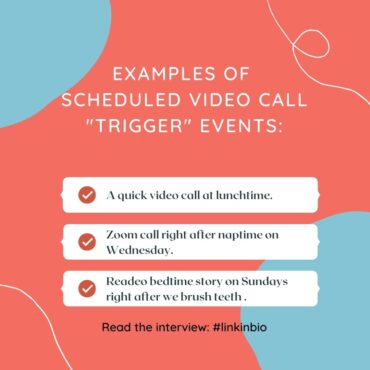 Better Facetime calls with grandchildren starts with a schedule that is prompted by a “trigger” event. The trigger should be something that happens on a regular basis.
Better Facetime calls with grandchildren starts with a schedule that is prompted by a “trigger” event. The trigger should be something that happens on a regular basis.
Involve Your Children in planning!
So I guess as much as we are talking about what grandparents can do, and maybe use the Bingo board to be inspired, don’t forget to ask the kids! They may have some really cool ideas that you’ve never thought about, and they’re going to be super excited to share that with you.
Just as grandparents are wanting to connect to grandkids, grandkids really want to spend time with their grandparents. So that’s something I wanted to remind you of and make sure people have in mind to include them in that.
Hint #3: Make Space in Your Schedule Through Communication!
And then the last piece, we talked a little bit about scheduling. Just a practical component with it is, as a family, we have to have welcoming and encouraging conversations around the reality of our schedule. My son could take control of a phone for an hour and a half. So we also have to be respectful and understand that sometimes maybe a grandparent only has a half-hour. Or, “We can’t talk now, but we’ll talk soon.”
For all parties involved, we have to be comfortable sharing that with each other. If it doesn’t work out now, or it only works out for 15 minutes, that’s fine. And learning to communicate with each other around your schedules so that we can enjoy time is important. Because you do kind of know if somebody isn’t really able to spend the time. That comes across. You can’t really hide it if you’re anxious to go get groceries or go to a doctor’s appointment in a few minutes. So it’s a good communication point to keep open communication and let people know what time you can invest.
We have a NEED to Engage Remotely
Lynnae: I wanted to share one quote that you wrote when we were initially discussing how to improve our FaceTime calls with Grandchildren:
“As a world, we have a real need to ENGAGE remotely. We have the tools, but we still don’t have the mental systems and structures to help us really capitalize on those tools. This will continue to be relevant and will become more and more relevant in the future. We are no longer bound to a region, but this will make it more important to make our closest ties present.”
I love that quote, and I love the idea that you have mentioned that, “social media is a terrible place to go if you want to know whether or not you are loved.” Do you want to elaborate on that some more?
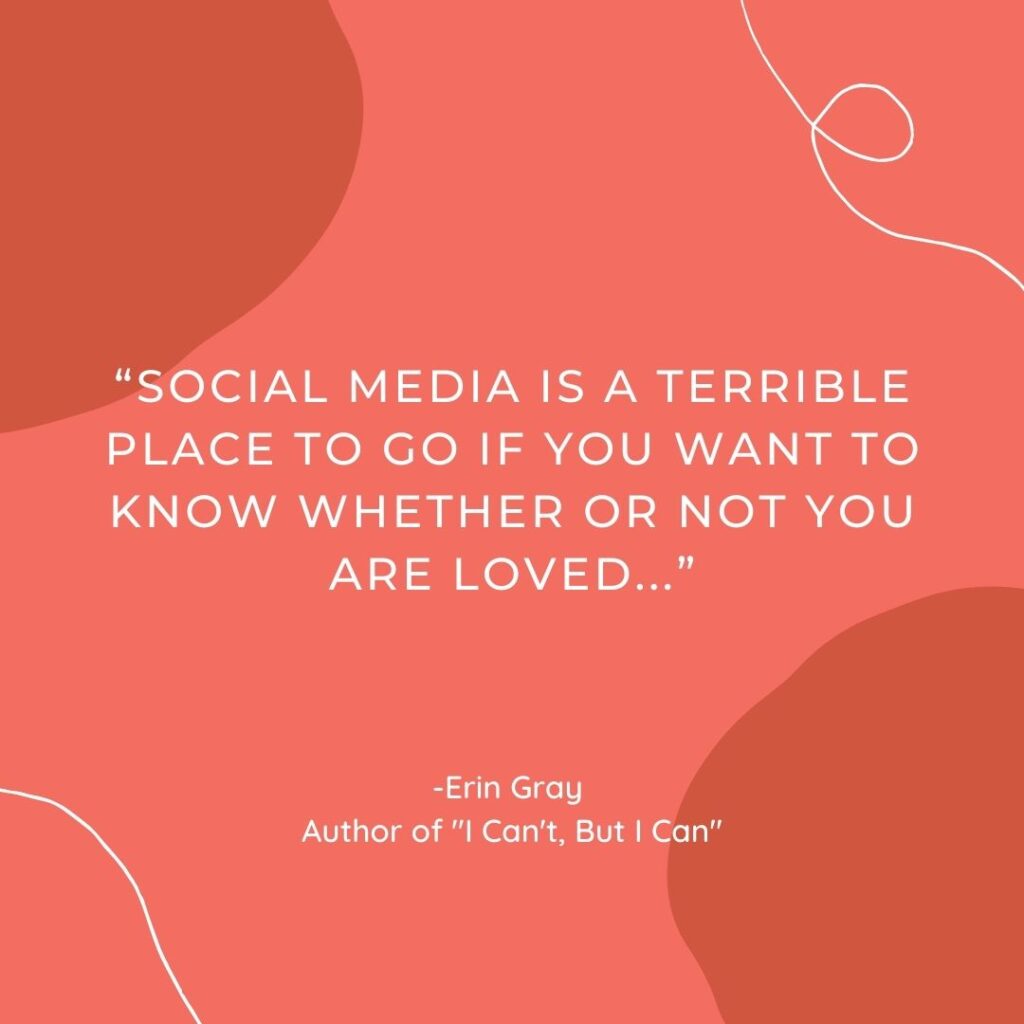
Hint #4: Grandparents Have a Unique Opportunity To Create Connection Via FaceTime Calls with Grandchildren
Erin: So we have these tools, and you see this on Facebook or Snapchat or Instagram. You have places where People are putting very personal things out there to their followers, and they may have many many followers, but oftentimes on that venue, you don’t get the support and love and compassion that you need. It doesn’t mean that these tools are bad, but they’re not necessarily the right platform for that. So if we could help people to know that, if I really need encouragement and a face-to-face connection that shows that I’m loved, where do I go to find that?
Grandparents have this opportunity that as they build these relationships with our grandkids, they know that they can, rather than blasting it out on Facebook, they know that they can come to you. They can come to you for a FaceTime call that will be like sitting down across the table with a cup of coffee with you when they are struggling. They’ll know that you care and that you are there and have developed those communication patterns so that this is not weird or awkward or distant, even though we might be many, many miles apart.
Lynnae: I think that’s so important. I think of the relationship that I had with My grandparents, for example, and how that impacted my own life. I wish for that for all of my children and grandchildren to have that connection with a grown-up they love that works the way mine did. Focusing on improving my FaceTime calls with grandchildren would be a great starting point!
Tell us where to get your book. Where’s the best place for people to find that?
Erin: Yes, You can find me on Barnes & Noble, you can search on that website. I’m listed there as well as amazon.com. You can find my book either place.

